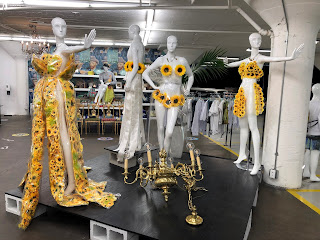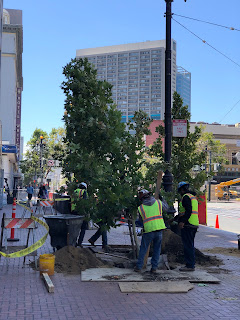38. Dave Eggers, Zeitoun (2009) (7/12/21)
I picked up this book because I own it, and because it's by Dave Eggers, who happens to be the husband of Vendela Vida, author of my last-reviewed book. I'm not sure I even realized it was about Hurricane Katrina and its aftermath, never mind the story of a Syrian immigrant and successful businessman—a building contractor—in New Orleans, Abdulrahman Zeitoun. Or simply Zeitoun, as he is known all over town.
The book itself is gripping, proceeding from just a couple of days before Katrina, as that storm was spinning toward NO and people were being warned to evacuate—which the main character Zeitoun's wife, Kathy, did with their four children, but he elected to stay behind, because he "always did" whenever a hurricane blew through, and the better to watch over their many properties. Once the storm hits, in a relatively brief description—it lasted a matter of hours, from the night of August 28, 2005, into the next day—we watch as Zeitoun hunkers down, and then he gets in his aluminum canoe and starts paddling through the flooded streets, helping stranded neighbors to safety, feeding left-behind dogs: doing what he can. In this, he feels "called upon" by God.
But the city is growing increasingly toxic, and it is ridden by looters and filling with military personnel. On Tuesday, September 6, he and three companions are roughly arrested and conveyed to a makeshift high-security prison at the downtown Greyhound station, with no recourse to a phone call or any sort of justice. Zeitoun and another Syrian are suspected of being terrorists. From there, three days later, they are removed to an established prison near Baton Rouge.
No one knows where Zeitoun is. The story is now told from Kathy's point of view, now from Zeitoun's, as she desperately tries to track him down after receiving a hurried phone call from a missionary on September 18, almost two weeks after his arrest. Slowly, the wheels of justice begin to grind. Zeitoun is finally released on the 29th. His companions end up remaining in the prison for five, six, and eight months longer.
The descriptions at the start, when Zeitoun is paddling about doing what he can, are almost serene:
There was the canoe. It called to him, floating and ready. It was a rare opportunity, he thought, to be able to glide over the roads. He had only this day. He bailed the water resting in the hull, and in his T-shirt and shorts and sneakers, he stepped in.
Leaving the yard was difficult. A tree across the street had been ripped from its roots and lay across the road, branches spread over his driveway. He paddled around them and looked back to the house. No great damage to the exterior. Some shingles missing from the roof. The windows broken. A gutter that would need remounting. Nothing too bad, three days' work.
In the neighborhood, other homes had been hit by all manner of debris. Windows had been blown out. Wet, black branches covered cars, the street. Everywhere trees had been pulled out of the earth and lay flat.
The quiet was profound. The wind rippled the water but otherwise all was silent. No cars moved, no planes flew. A few neighbors stood on their porches or waded through their yards, assessing damage. No one knew where to start or when. He knew he would be giving many estimates in the coming weeks.
At first, the water is clean, he's still got plenty of food. He sets up a tent on a flat roof of his house and sleeps outdoors. We are told in various flashbacks about his and Kathy's pasts—his relationship to the sea back in Syria, her conversion to Islam, how they met. But then with the arrest, we learn how criminally inhumane the incarceration of so many people was in the aftermath of Katrina. All law and order seemed to have vanished..
It is what we outside the vicinity of New Orleans heard about afterward, but seeing it up close in a first-person view is that much worse. Eggers does a good job of slowing down into the horror. He finishes up several years later, describing how Zeitoun and Kathy are still rebuilding their lives, but in a way, both of them have been broken.
But here I lose my way a bit with what to say about the book—for it seems that at least some of the story that was relayed to Eggers may not have been entirely honest. A half dozen years after these events, Kathy sued Zeitoun for divorce, alleging physical violence during the whole of their marriage (there is not even a hint of that in the book) and, ultimately, attempted murder. I've seen accounts by New Orleans residents alleging that Zeitoun and his cousins were con men, that they weren't the universally beloved businessmen that Eggers suggests. These accounts, of course, are just gossip and rumors, not necessarily any more accurate than Eggers's account. Perhaps, in the end, the book is merely an elaborate fiction, spun to tell a particular story. Eggers, apparently, does not talk about these troublesome developments. Here, rather, is what he says about how he learned the story and came to "trust it to the bones."
The charges of ongoing violence from early on in the marriage aside, I am fully convinced of the details of what Zeitoun experienced with Katrina. And I would not be surprised if he was, in fact, "broken" as a result. Both he and his wife were no doubt damaged (she, for one, suffered from memory lapses and an inability to understand speech) and seriously changed by those events. And life has gone on for them nevertheless. Learning about the ugly follow-up makes me feel sad. The book itself ends on a note of hopefulness and strength. But Zeitoun is not a superhero; he's just a human. I hope both he and Kathy can find peace.


















































